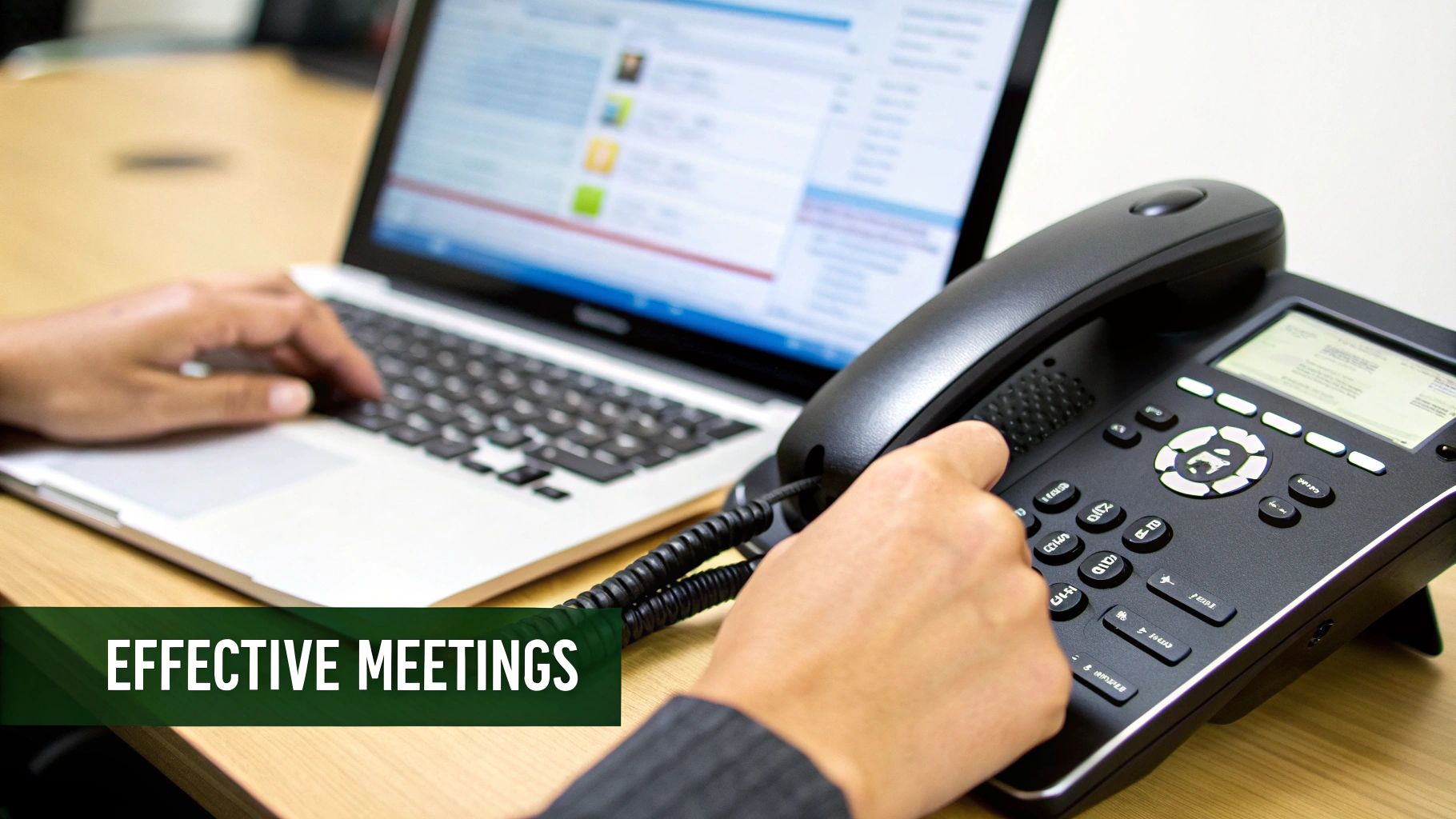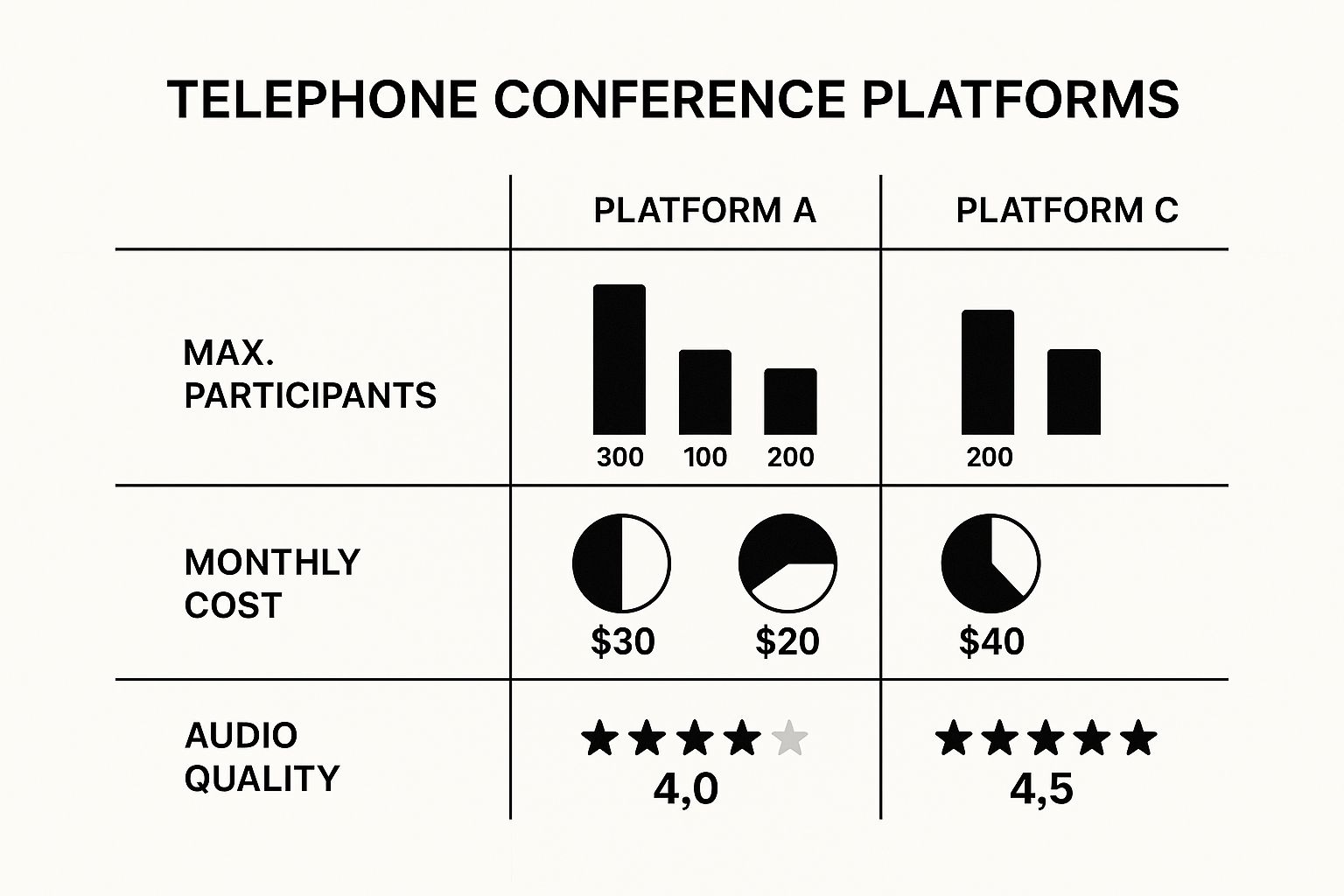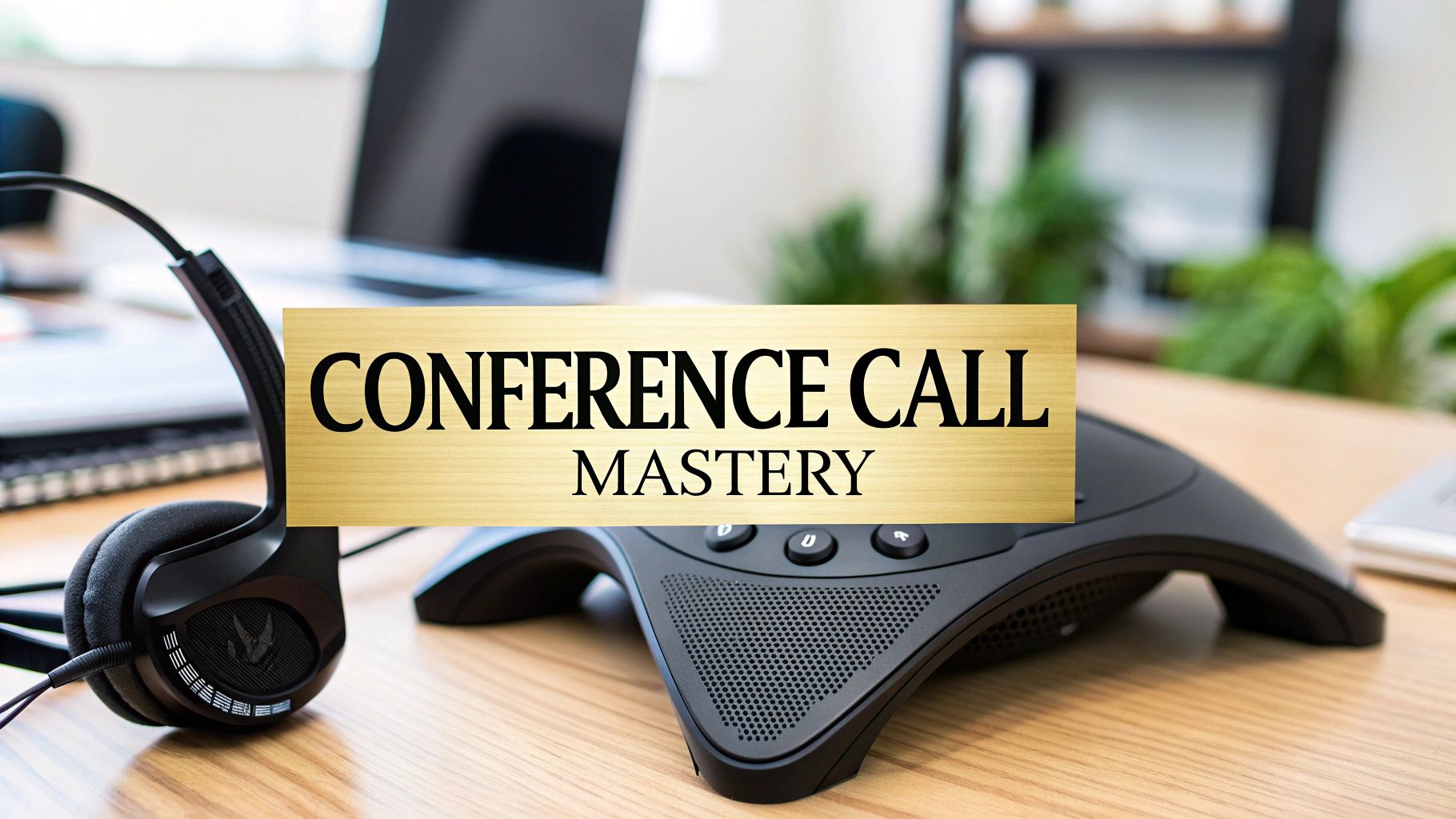At its core, a telephone conference meeting is a virtual roundtable built on audio. It brings multiple people together from different locations using just a phone line, allowing teams to connect and collaborate without the need for video. This makes it one of the most straightforward and reliable tools for group communication.
What Is a Telephone Conference Meeting

Imagine a bridge made entirely of sound. That's essentially what a telephone conference is. It instantly connects professionals across cities, states, or even countries, bypassing the need to install special software or worry about a spotty internet connection messing with your video feed. It’s a classic for a reason—it boils communication down to what matters most: the conversation itself.
The process is incredibly simple. A host sets up the call and shares a dial-in number and an access code with everyone invited. When it's time to meet, each person just calls that number, punches in the code, and is instantly connected to the group's shared audio space. It works on any phone you can think of, from an old-school landline to the newest smartphone.
The Technology Behind the Call
While the experience for the user is simple, the technology making it happen has come a long way. Early conference calls ran on traditional phone networks, but today, many services use Voice over Internet Protocol (VoIP). This technology sends the audio over the internet, which often results in much clearer sound and opens the door to more advanced features.
This shift is particularly noticeable in places that have invested heavily in digital infrastructure. The United Arab Emirates, for example, has embraced telephone conferencing, driven by a mobile penetration rate that soared past 280% by 2024. The country's widespread 5G network delivers the high-speed, low-latency connection perfect for crystal-clear audio, solidifying the conference call's place in modern business. You can learn more about the region's communication trends at menacomm.org.
A telephone conference meeting prioritizes accessibility and reliability. It is the go-to solution when connectivity is unpredictable or when the conversation's focus needs to be entirely on clear, direct dialogue without visual distractions.
In the end, the lasting power of the telephone conference comes from its simplicity. It’s a dependable workhorse for remote collaboration, client calls, and quick team sync-ups, proving that you don't always need a screen to have a powerful conversation.
Your Essential Toolkit for a Flawless Call

A successful telephone conference meeting isn’t just about having a dial-in number; it's about the quality of the connection. The right gear—both hardware and software—is what separates a productive, clear conversation from a frustrating one. Think of it as the backstage crew that makes the main event run smoothly.
Let’s start with the hardware. Sure, you can technically join a call from any old phone, but dedicated equipment elevates the entire experience. A quality headset with a noise-canceling microphone is a game-changer for individuals. It isolates your voice and cuts out the background chatter, ensuring you come through crystal clear.
When you have a group of people in one room, a central speakerphone is a must. These aren't just speakers; they're designed to pick up sound from all around the table and cancel out that annoying echo, making the conversation feel much more natural for everyone.
Picking the Right Conferencing Software
Once your hardware is sorted, the software service is the engine driving the call. Not all platforms are built the same, and they generally fall into one of two camps:
- Basic Services: These are often free or very low-cost and are perfect for small, informal chats. You'll get the essentials like a dial-in number and an access code, but watch out for limits on how many people can join or how long you can talk.
- Enterprise-Grade Solutions: Built for business, these paid services offer much more. We're talking superior audio quality, tighter security, and powerful features like call recording, automatic transcription, and reporting analytics.
The best service is the one that fits your real-world needs. A small startup might do just fine with a basic option, but if you're holding sensitive client meetings, the security and reliability of an enterprise platform are non-negotiable.
At the end of the day, investing in a solid toolkit is what turns a simple phone call into a professional telephone conference meeting. It’s your guarantee that the technology helps your collaboration, rather than getting in the way.
Your Step-by-Step Guide to Hosting a Meeting
Running a great telephone conference meeting isn’t about winging it; it’s all about smart preparation. When you have a solid plan, everyone shows up ready to contribute, and you can turn a basic phone call into a genuinely productive work session.
Let's walk through the steps to set the stage for a flawless meeting.
First things first: what’s the point of the meeting? Before you even think about sending an invite, get laser-focused on why you're gathering everyone. Are you trying to land on a final decision, brainstorm some fresh ideas, or just get a quick status update? This single objective is your north star—it dictates who needs to be on the call and how you’ll steer the conversation.
With your purpose locked in, it's time to build the agenda. Think of this as more than just a to-do list; it’s the roadmap for your entire call. By assigning a time slot to each topic, you keep the conversation from drifting and make sure you hit every important point. Sending this out ahead of time also lets everyone know exactly what to expect.
Finalizing the Logistics
Once you've got your "why" and your "what," you can tackle the technical side of things. Juggling different time zones is always a headache, so use a scheduling tool that makes it easy to find a time that works for everyone without making someone get up at 3 a.m.
After you've picked a time, get the actual conference call details ready to go.
Here’s a pro tip that many people skip: assign roles before the call starts. Having one person act as the moderator to keep things on track, another as a dedicated note-taker to capture decisions, and a third as a timekeeper makes a world of difference. It’s a simple move that dramatically improves the flow of the meeting.
To make sure everything is ready to go, run through this simple checklist before sending out the final invitation.
Pre-Call Setup Checklist
Follow these essential steps before every telephone conference meeting to ensure a smooth and productive session.
| Task | Action Required | Status |
|---|---|---|
| Define Goal | Write a one-sentence objective for the meeting. | ☐ |
| Create Agenda | List discussion topics with allocated times. | ☐ |
| Finalize Attendees | Confirm the list of essential participants. | ☐ |
| Schedule Call | Find a time that works across all time zones. | ☐ |
| Generate Dial-in | Create the unique conference line and access code. | ☐ |
| Assign Roles | Designate a moderator, note-taker, and timekeeper. | ☐ |
| Prepare Materials | Gather all reports or documents for pre-reading. | ☐ |
| Send Invitation | Distribute all information in a single email. | ☐ |
Once you’ve checked all the boxes, pull everything together into one clear email or calendar invite. Make sure it includes:
- Date and Time: State it clearly, and don't forget to list the different time zones.
- Dial-in Information: The phone number and the all-important access code.
- The Agenda: Attach the final version so everyone is on the same page.
- Supporting Materials: Include any documents or presentations people need to review beforehand.
Following this process takes the guesswork out of hosting. It guarantees that when people dial into your telephone conference meeting, they aren’t just present—they’re prepared, focused, and ready to make real progress.
Running Meetings That People Actually Engage In

Getting people to dial into a telephone conference meeting is one thing. Keeping them focused and participating is a whole other challenge. Left unchecked, a conference call can easily spiral into a confusing mess of people talking over each other or, worse, dead silence.
Your job is to transform what could be a passive listening exercise into a genuinely collaborative session.
It all starts with a strong opening. Don't just dive into the agenda. Take a moment for a quick roll call to see who's on the line. This simple step makes everyone feel seen and sets a professional, organized tone right from the start.
Next, lay down some ground rules. This isn't about creating a rigid, formal atmosphere; it's about respecting everyone's time. The number one rule? Ask everyone to mute themselves when they aren't speaking. It's a game-changer for cutting out distracting background noise and making sure the speaker can be heard clearly.
Moderating the Conversation for Maximum Impact
Think of yourself as the guide, not just another person on the call. It's up to you to keep the conversation flowing and, more importantly, on track. You have to be ready to steer things back if the discussion starts to wander.
A simple phrase like, "That's an interesting point, but let's stick to the agenda for now," can work wonders.
It’s also your responsibility to make sure everyone contributes, not just the loudest voices in the room. Don’t be afraid to gently call on quieter team members. Something as simple as, "Sarah, we haven't heard your thoughts on this yet," can open the door for valuable input that might have otherwise been missed. For a deeper dive into making your calls truly productive, learn how to run effective meetings.
Your main goal as a moderator is to turn a series of disconnected monologues into a real conversation. By actively managing the flow and ensuring everyone participates, you make sure the meeting actually accomplishes what it set out to do.
Mastering these skills is non-negotiable now that remote work and global teams are the norm. It’s a massive trend, with one GSMA report noting that over 75% of businesses in the UAE rely on telephone conferencing for their daily operations.
Choosing the Right Conference Call Service
Picking the right service for your telephone conference meeting can feel a bit overwhelming. You've got everything from basic dial-in numbers to full-blown communication platforms, and the best choice really boils down to what your business actually needs. Not all providers are built the same, so knowing what you're looking for is half the battle.
First, take a hard look at your typical use case. How many people are usually on your calls? Do you need to record conversations or get transcripts for your records? Answering these basic questions will immediately help you filter out the noise and avoid paying for fancy features you'll never touch.
This infographic breaks down some of the key differences between various platforms, comparing things like how many people can join, the monthly cost, and overall audio quality.

As you can see, there's a clear relationship between cost, capacity, and the number of features you get. This should help you find a provider that fits both your budget and your operational needs.
Comparing Conference Call Service Options
To make it even clearer, let's look at a side-by-side comparison of the different telephone conferencing solutions. This table should help you figure out which type is the best fit for your team.
| Feature | Dedicated Dial-In | VoIP System | Unified Communications Platform |
|---|---|---|---|
| Best For | Simple, audio-only calls | Businesses with existing IP phones | Companies needing all-in-one collaboration |
| Setup Complexity | Very Low | Moderate | High |
| Core Features | Dial-in number, PINs, basic controls | Voice, call forwarding, voicemail-to-email | Voice, video, chat, file sharing, screen sharing |
| Integration | Limited to none | Integrates with CRMs and business apps | Deep integration across entire tech stack |
| Cost Model | Per-minute or flat monthly fee | Per-user, per-month subscription | Higher per-user subscription fee |
Ultimately, the right choice depends on your scale. A small team might be perfectly happy with a dedicated dial-in, while a larger, more integrated company will get far more value from a unified platform.
Key Factors for Your Decision
As you weigh your options, keep these critical factors in mind. They'll help you make a smart choice that provides real value for years to come.
- Audio Quality: This is non-negotiable. If people can't hear each other clearly, the meeting is a waste of time. Look for providers that offer HD voice to eliminate static, echoes, and dropped words.
- Security: If you're discussing sensitive information, security is paramount. Prioritize services that offer features like end-to-end encryption and unique moderator passcodes to keep your conversations private.
- Participant Capacity: Make sure the service can handle your biggest meetings without breaking a sweat. You don't want to hit a participant cap or get slapped with extra fees just because the whole team needs to join.
- Integration: How well does the tool play with the software you already use? Many modern businesses are pulling all their communication tools together, even incorporating solutions like a WhatsApp call center to keep all customer interactions in one place.
Think of your final choice as a strategic investment. A solid conference call service doesn't just make meetings run smoothly—it polishes your professional image, strengthens team collaboration, and becomes a cornerstone of your entire communication strategy.
Where Audio-Only Collaboration is Headed
While video conferencing seems to grab all the headlines, the humble telephone conference meeting is quietly getting a massive upgrade. Its future isn't about trying to beat video at its own game. Instead, it’s about doubling down on its core strengths—simplicity and reliability—and adding a layer of serious intelligence.
That’s where artificial intelligence comes in. Imagine hopping on a call where AI provides a real-time transcript on the fly. When the meeting ends, you instantly get an automated summary with every key decision and action item clearly listed. This isn't just about convenience; it turns a simple audio call into a fully documented, productive work session where nothing important gets missed.
Smarter Integration and Proven Growth
Modern audio conferencing tools aren't standalone silos anymore. They’re being woven directly into the fabric of the broader communication platforms we use every day, cementing their role in our hybrid work lives.
This isn't just a global trend; we’ve seen it happen right here in the UAE. Telephone conferencing evolved from old-school ISDN lines in the 2000s to the widespread adoption of VoIP after 2010. By 2023, more than 90% of large businesses here reported using it regularly, which speaks volumes about its lasting value. You can find more details on this regional network evolution at futurenetworld.net.
Of course, as we think about what's next for collaboration, it's worth exploring top interactive video platforms to see how visual engagement is evolving. But even with those advancements, the fundamental appeal of a clear, straightforward audio connection remains powerful. Tools like Zoom Phone are constantly refining this audio-first experience. If you're interested, we put together a complete guide to Zoom Phone features.
The bottom line? The future of the telephone conference meeting is focused, intelligent, and more connected to our workflows than ever before.
Frequently Asked Questions
Even after you've got the basics down, you'll probably still have some questions about running a solid telephone conference meeting. Let's tackle some of the most common ones head-on, so you can feel more confident managing your calls.
Common Queries Answered
How many people can I actually have on a conference call?
This really comes down to your service provider and the specific plan you're on. Some free services might cap you at around 10 to 25 attendees, which is fine for small teams. But for bigger events, enterprise-level solutions are built to handle hundreds of participants without a problem. Just make sure you check the participant limit before you sign up.
When does it make more sense to use audio instead of video?
Audio-only meetings are the clear winner when you need simplicity and a rock-solid connection. Think of situations where people are on the move, dealing with spotty internet, or when you just don't need slides or screen sharing. It's also a great way to fight that "video fatigue" we all feel, keeping everyone's attention purely on the conversation.
Choosing audio is a strategic move, not a compromise. When your goal is crystal-clear communication and accessibility for everyone, a good old-fashioned telephone conference is often the best tool for the job.
Is a telephone conference meeting actually secure?
The security really varies from one provider to the next. Any reputable business service should offer the essentials: unique passcodes for every call, a separate PIN for the moderator, and end-to-end encryption. If you're discussing anything sensitive, you absolutely need to pick a provider that takes security seriously and get in the habit of using fresh access codes for each meeting.
What's the best way to get better audio quality on my calls?
For the clearest sound, skip the speakerphone and use a proper headset with a built-in microphone. It makes a world of difference. Also, get everyone in the habit of muting themselves when they aren't talking—it cuts down on distracting background noise instantly. Finding a quiet spot with a stable connection is a simple but effective step, too.
If you're still running into issues and need some expert advice on your setup, feel free to get in touch with our technical team for a consultation.
At Cloud Move, we specialize in reliable, high-quality telephony solutions that make every telephone conference meeting clear, secure, and professional. Find out how we can help your business communicate better at https://cloud-call-center.ae.




